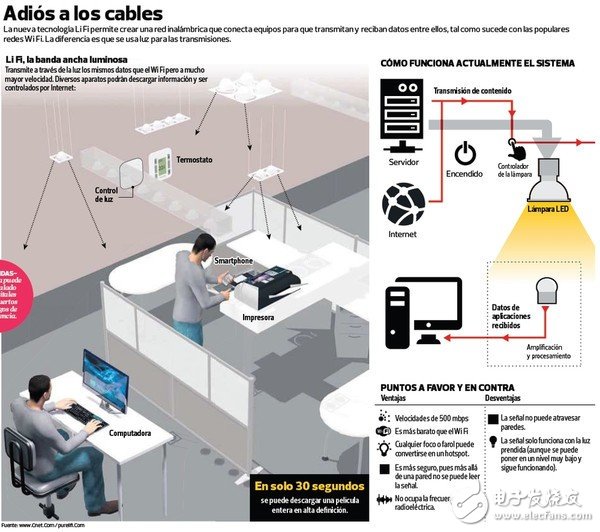WiFi technology has become more and more popular, but there are more and more people complaining about unstable wireless signals, slow Internet access, and too few WiFi hotspots. Now, there is a new technology that may solve these problems.
Visible light wireless communication (called Li-Fi - LightFidelity) uses wireless signals to transmit information wirelessly, and is now ready to compete with WiFi. What kind of transmission technology is LightFidelity?
Li-Fi is short for "LightFidelity", a new wireless data transmission technology developed by the famous British physicist Harald Haas, which can complete the whole process with ordinary light bulbs. While turning on the room lights, the user also turned on the internet connection.

This device, called Li-Fi, can be used to transmit wireless data from the "white space" of the television band or unused satellite signals. The invention, dubbed "D-Light," transmits data by changing the frequency of room illumination, transmitting more than 10 Mb per second, comparable to a typical broadband connection.

The Li-fi principle is completely feasible to encode information in light according to different rates. For example, LED on indicates 1 and OFF indicates 0, and information can be transmitted through a fast switch.
Due to the luminous intensity of the LED, the human eye does not notice a rapid change in light. At the heart of this technology is a new generation of high-brightness LEDs. The principle is actually very simple. When the LED is on, it means that a digital number is transmitted. When it is turned off, a zero is transmitted. The LED can be quickly switched between light and dark, so that data can be transmitted very efficiently.
For a long time, hanging a light bulb above a person's head has been used as a metaphor to symbolize the inspiration of each inventor's aura. However, the German physicist pioneer Haas was led by the light bulb itself. Haas and his team at the University of Edinburgh in the UK invented a new patented technology that uses flashing lights to transmit digital information. This process is called visible light communication (VLC).
Haas then wanted to use the light bulb to act as a communication device, claiming that the data could be sent by adding a microchip to any inconspicuous LED bulb that transmits data in millions of flashes and turns off every second. The fast blinking of the LED is equivalent to the transmission of the binary code, which is invisible to the naked eye but can be received by the photosensor. It's like sending a Morse code with a torch, but using data letters that are faster and computer-readable, Haas explained.
The radio wave data transmission method is not efficient. With the help of mobile phones, there are now 1.4 million base stations responsible for enhancing the signal, but most of the energy is used for cooling, and the efficiency is only 5%. In contrast, there are 40 billion light bulbs used worldwide, so they have higher efficiency. Simply change the traditional incandescent lamp to an LED light to turn the light bulb into a wireless network transmitter.
The current wireless data transmission method is inefficient electromagnetic waves, especially radio waves. Radio waves have many limitations, they are rare, expensive, and have only certain bands. These limitations make it impossible to keep up with the pace of wireless data, making efficiency an impossible. Light is part of the electromagnetic spectrum and it should be a great practice to use it for wireless communication.
The space of the visible spectrum is 10,000 times that of radio waves, making it the most ideal band to use. In one presentation, Haas showed a table lamp that uses LED lights to transmit data like a receiver under the table. As soon as you put your hand into the beam, the video signal is transmitted to the screen behind you. Once the signal is blocked, it stops playing.

Recently, German scientists have successfully used Li-Fi optical technology to transmit data at a speed of up to 12.5 GHz/s over a short distance through half-duplex and full-duplex modes, achieving another breakthrough in Li-Fi transmission technology.
Although Li-Fi wireless communication technology has better performance than Wi-Fi in terms of transmission speed and cost, and does not use electromagnetic waves to make users feel healthier, it has a clear weakness. Visible light cannot penetrate the object, so if the receiver is blocked, the signal will be cut off. But many scholars have pointed out that if the optical signal is blocked and you need to use the device to send information, you can seamlessly switch to the RF signal, so visible light communication is not a competitor of Wi-Fi, but a complementary technology. This will help release the spectrum space. It is important to know that the current visible spectrum is not being used and is not regulated, so we can perform high-speed communication.

Some analysts point out that Li-Fi will grow rapidly between 2015 and 2020
Although Li-Fi technology is still in the research and development stage, from the concept point of view, we have found this wireless transmission technology that seems to be more "clean" than radio frequency, and it is more cost-effective to use light for signal transmission.
Intelligent Street Lights,Intelligent Track Lighting,Green Intelligent Lighting,Intelligent Led Street Lighting
Jiangsu Bosiwei Optoelectronics Group Co.,ltd , https://www.bswledled.com